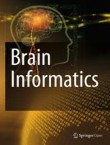Citation Impact 2023
Source Normalized Impact per Paper (SNIP): 1.543
SCImago Journal Rank (SJR): 1.016
Speed 2023
Submission to first editorial decision (median days): 13
Submission to acceptance (median days): 128
Usage 2023
Downloads: 302,950
Altmetric mentions: 141
A novel spectral entropy-based index for assessing the depth of anaesthesia
Anaesthesia is a state of temporary controlled loss of awareness induced for medical operations. An accurate assessment of the depth of anaesthesia (DoA) helps anesthesiologists to avoid awareness during surge...
